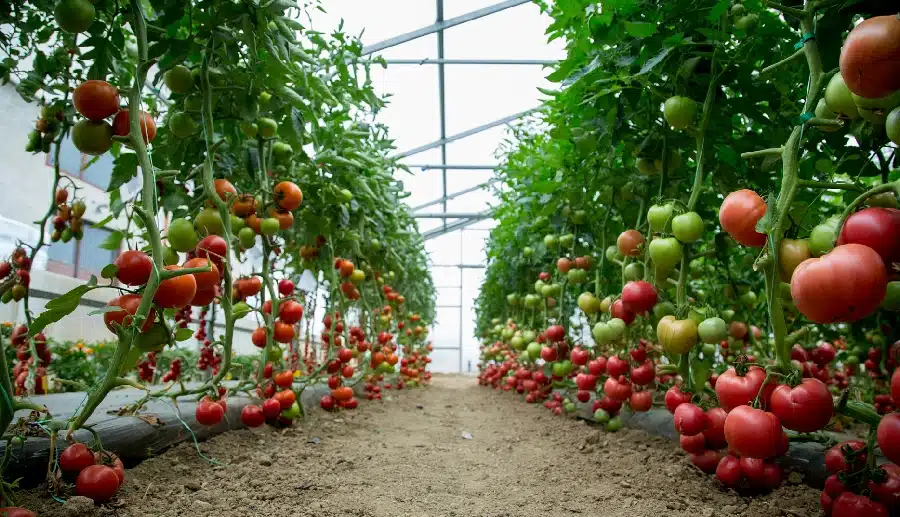Protected Cultivation Techniques of Tomato
- Tomato (Lycopersicum esculentum) is one of the most important vegetable crops grown under protected cultivation due to its high market demand, sensitivity to environmental fluctuations, and excellent response to controlled conditions.
- Protected structures such as greenhouses, shade nets, and polyhouses provide a favorable environment for tomato cultivation, enabling year-round production, higher yields, and better quality fruits with reduced pest and disease pressure.

A. Importance of Tomato Cultivation under Protection
- Ensures off-season production and premium market price.
- Protects against extreme temperatures, rain, hail, and wind.
- Minimizes damage from insect-pests and diseases.
- Allows efficient water and nutrient management through fertigation.
- Improves fruit quality (uniform size, color, and shape).
- Increases yield per unit area by 2–3 times compared to open-field conditions.
B. Suitable Structures for Tomato Cultivation
- Naturally Ventilated Polyhouses: Most common in tropical/subtropical regions, cost-effective.
- Insect-proof Net Houses: Useful for nursery raising and early growth stages.
- Greenhouses with Environmental Control: For high-value, export-oriented production.
- Low-cost Walk-in Tunnels: Short-duration, seasonal protection.
C. Varieties reported or recommended in Nepal for protected cultivation
a. Khumal Golbhenda Hybrid-2
- Hybrid, globe type fruit, bred for improved yield and uniformity.
- Suited to polyhouse/greenhouse for marketable round tomatoes.
b. Khumal Golbhenda Hybrid-3
- Successor hybrid with similar or improved traits over Hybrid-2.
- Recommended where hybrid seed supply is available.
c. Srijana
- Widely trialed in Nepal; good yield and stability under late blight pressure.
- Preferred by growers wanting reliable performance under disease risk.
d. Thims 1
- Performed well in plastic house trials across mid and high hill altitudes.
- Larger fruit size, adaptable to a range of protected microclimates.
e. Thims 16
- Alternative tested variety for protected cultivation; moderate fruit size and yield.
- Useful where Thims 1 is unavailable or for staggered planting.
f. Bishes
- Local trial variety used in protected conditions; smaller fruit size, lower input demand.
- Suited to smallholders or niche local markets.
D. Nursery Raising
- Seeds are sown in protrays filled with sterilized cocopeat-perlite-vermiculite medium.
- Each cell sown with one treated seed.
- Seedlings ready in 25–30 days.
- Nursery maintained under insect-proof net house to avoid viral diseases.
E. Land Preparation and Planting
- Raised beds of 1 m width, 15–20 cm height, convenient length.
- Bed soil sterilized (solarization or formalin drenching).
- Drip irrigation system installed before planting.
- Plant spacing: 90–100 cm between rows and 40–50 cm between plants (double-row system on raised bed common).
- Seedlings transplanted with root ball to avoid shock.
F. Training and Pruning
Tomato hybrids under protected cultivation require systematic training for optimum canopy management.
a. Training system:
- Vertical staking using nylon twines tied to overhead wires.
- Plants wound around twines as they grow.
b. Pruning:
- Side shoots (suckers) removed weekly to maintain single or double stem.
- Lower leaves removed gradually to improve aeration and reduce disease.
c. Topping: Terminal shoot pinched after desired truss formation (typically 6–8 trusses).
G. Nutrient Management
- Fertigation is the standard method under protected cultivation.
- Basal application: Well-decomposed FYM (15–20 t/ha) before planting.
- Fertigation schedule (approximate): Nitrogen: 200–250 kg/ha, Phosphorus: 100–120 kg/ha. And Potassium: 200–300 kg/ha.
- Water-soluble fertilizers (19:19:19, 13:0:45, CaNO₃, MgSO₄) are commonly used.
- Micronutrients supplied as foliar sprays (Boron, Zinc, Calcium).
H. Irrigation Management
- Drip irrigation provides efficient water use.
- Frequency: Daily or alternate-day irrigation depending on soil and climate.
- Water requirement: 2–3 liters per plant per day at peak growth.
- Overwatering avoided to prevent root diseases.
I. Environmental Control
- Optimum temperature: 20–28°C (day), 15–18°C (night).
- Relative humidity: 60–70%.
- Ventilation through side and top openings.
- Shade nets (30–40%) may be used during summer.
- Foggers/misters used for cooling during hot months.
- In winter, low-cost heating or mulching can be applied.
J. Use of Plant Growth Regulators (PGRs)
- Auxins (NAA, 20–30 ppm): Improve fruit set under low temperatures.
- Gibberellins (GA₃, 10–20 ppm): Increase fruit size and reduce flower drop.
- Ethephon (200–250 ppm): Used for uniform ripening.
K. Major Pests
- Whitefly – vector of Tomato leaf curl virus.
- Thrips – cause leaf curling and transmit tospoviruses.
- Aphids – transmit mosaic virus.
- Fruit borer (Helicoverpa armigera) – damaging at fruiting stage.
Management:
- Insect-proof nets, yellow sticky traps, neem oil sprays, release of predators (Encarsia spp.).
- Avoid insecticide residues in protected crops.
L. Major Diseases
- Tomato Leaf Curl Virus (ToLCV).
- Powdery Mildew (Oidium spp.).
- Early Blight (Alternaria solani).
- Fusarium and Bacterial wilt.
Management:
- Use resistant/tolerant hybrids.
- Seedling treatment with Trichoderma or biofungicides.
- Prevent entry of infected seedlings.
- Maintain proper ventilation and avoid high humidity.
M. Harvesting and Yield
- First harvest begins 70–80 days after transplanting.
- Fruits harvested at breaker or turning stage for distant markets, red ripe for local sales.
- Harvesting interval: Every 3–4 days.
N. Yield:
- Open field: 40–60 t/ha.
- Protected cultivation: 120–150 t/ha under proper management.